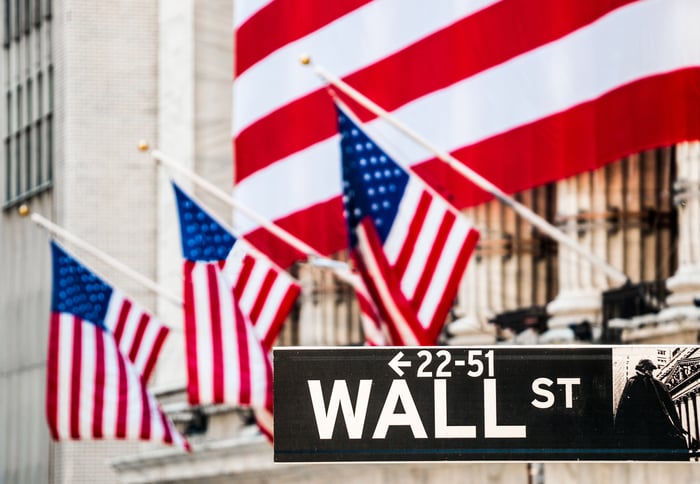For the past 126 years, the iconic Dow Jones Industrial Average (^DJI 0.56%) has served as a barometer of the stock market's health. The index, which was once comprised of 12 mostly industrial stocks, is now composed of 30 highly profitable, multinational companies.
In many respects, the Dow Jones is home to mature and generally slower-growing businesses. Of course, you shouldn't mistake a "mature" business for one that can't make patient investors richer.

Image source: Getty Images.
What you might be surprised to learn is that the Dow is also home to a number of high-growth companies. According to five-year earnings growth forecasts from Wall Street, the following five Dow stocks are expected to deliver average annual earnings-per-share (EPS) growth ranging from 16% to 42.6%.
Walt Disney: 42.6% average annual EPS growth over the next five years
Go ahead and raise your hand if you thought Walt Disney (DIS 0.16%) would be the fastest-growing stock in the Dow Jones industrial Average on an earnings basis over the next five years. If you have your hand up, you're probably lying to yourself or cheating.
If you're wondering why the "House of Mouse" is expected to grow by a blistering 42.6% per annum, look no further than the COVID-19 pandemic. Historically challenging years at the company's theme parks and for its movie studio segment should create a scenario where all facets of its operations bounce back strongly in the years to come.
Keep in mind that very few businesses in the world -- let alone the Dow Jones -- are able to transcend generational gaps as easily as Disney. Whether it's helping a grandparent connect with their grandchild at the theater or bringing a family together to enjoy a day at Disneyland, the nostalgia and branding Disney brings to the table is practically unmatched.
To boot, streaming-service Disney+ is growing like wildfire. As of April 2, 2022, Disney+ had 137.7 million paying subscribers, which was up 33% from the prior-year period. While it took Disney about 2 1/2 years to reach 137.7 million streaming subscribers, Netflix needed over a decade to reach this mark. By the midpoint of the decade, Disney+ should evolve into a positive cash flow driver for the company.
Chevron: 24.1% average annual EPS growth
Let's try this again: Who had oil major Chevron (CVX 1.54%) as the Dow's second fastest-growing stock over the next five years? I wouldn't expect too many hands to be up, given that oil stocks traditionally deliver modest growth.
Similar to Disney, Chevron's rapid earnings-growth potential is a function of it bouncing back so voraciously from the demand cliff that it (and the industry) faced during the pandemic. Whereas crude oil and natural gas demand plummeted in April 2020, the price for both commodities recently hit multidecade highs.
For Chevron to deliver 24.1% per-annum EPS growth over the next five years, Wall Street must foresee oil and natural gas prices remaining elevated. This isn't a far-fetched prognostication, given that capital investments in drilling and exploration were significantly reduced during the pandemic. And Russia's invasion of Ukraine has further complicated the global energy supply chain.
Chevron should also benefit from a number of international projects. Both the Wheatstone and Gorgon Projects should solidify Chevron's position as a top natural gas and liquified natural gas supplier in the Asia-Pacific region, while the Big Foot deepwater project in the Gulf of Mexico possesses more than 200 million recoverable oil-equivalent barrels. If oil and gas prices remain high, Chevron's higher-margin upstream segment should thrive.

Image source: Getty Images.
Boeing: 20.2% average annual EPS growth
Keeping with this head-scratching theme, which one of you had commercial and military aircraft developer and manufacturer Boeing (BA -0.24%) as the third fastest-growing stock in the Dow? According to Wall Street, Boeing's EPS growth should top 20% annually over the coming five years.
As with Disney and Chevron, Boeing's rapid EPS growth appears to be a function of the company rebounding from a historically poor operating performance during the pandemic. This is a company that had its prized 737 MAX grounded for approximately two years, due to a combination of electrical and safety concerns. Although the 737 MAX is now back in the air, deliveries of the Boeing 787 Dreamliner have been put on ice until the Federal Aviation Administration provides certification.
Although Boeing is climbing a wall of worry, there have been silver linings. For instance, the company ended March with a total backlog of $371 billion, which includes nearly 4,200 commercial airplanes. If fuel costs continue to rise, the impetus for airlines to upgrade their fleets to more fuel-efficient planes could provide a nice lift for Boeing.
Furthermore, 737 MAX production appears to be on track to ramp from 27/month at the beginning of 2022 to 47/month by the end of 2023. If Boeing can overcome near-term supply chain challenges, this sizable uptick in output could really boost its operating cash flow.
Visa: 18.2% average annual EPS growth
The fourth fastest-growing stock in the Dow Jones is, arguably, the first stock that doesn't come as a complete surprise. Payment-processor Visa (V -0.59%) is forecast to grow its earnings by a little over 18% annually over the next five years.
The real beauty of Visa's operating model is its cyclical ties. Even though recessions are an inevitable part of the economic cycle, periods of contraction typically last for a couple of quarters. That compares to economic expansions, which are almost always measured in years. Payment processors like Visa are able to take advantage of the natural expansion of the U.S. and global economy over time.
Investors should also note that Visa lays claim to the pole position in the leading market for consumption in the world. As of 2020, it controlled a 54% share of U.S. credit card network purchase volume. Not only is this 31 percentage points above the next-closest competitor, but Visa expanded its share of credit card network purchase volume in the U.S. more than any other major payment processor since the end of the Great Recession in 2009.
Another key point about Visa is that it strictly acts as a processor and not a lender. While it would have no trouble collecting interest income as a lender, doing so would expose it to potential loan delinquencies during recessions and economic contractions. Visa's avoidance of lending helps keep its profit margin above 50%.
Salesforce: 16% average annual EPS growth
Last but not least is cloud-based customer relationship management (CRM) software provider Salesforce (CRM -0.57%), which is actually the fastest-growing stock on a revenue basis within the Dow. On an EPS basis, Wall Street is looking for an average of 16% annual growth for the next five years.
Cloud-based CRM software is used by consumer-facing businesses to enhance existing customer relationships and boost sales. Businesses are using CRM software to handle product and service issues, manage online marketing campaigns, and run predictive analyses to determine which clients are likeliest to purchase a new product or service.
What makes Salesforce so special is its leading role in the CRM space. According to a report from IDC, Salesforce brought in nearly 24% of global CRM revenue in 2021. That's more than four times the market share of its next closest competitor, and it effectively solidifies Salesforce as the go-to company in this double-digit growth industry.
One final key to Salesforce's success is its co-founder and co-CEO Marc Benioff. He has made numerous earnings-accretive acquisitions, including MuleSoft and Tableau Software. These deals help to expand the company's ecosystem and have provided ample cross-selling opportunities.





